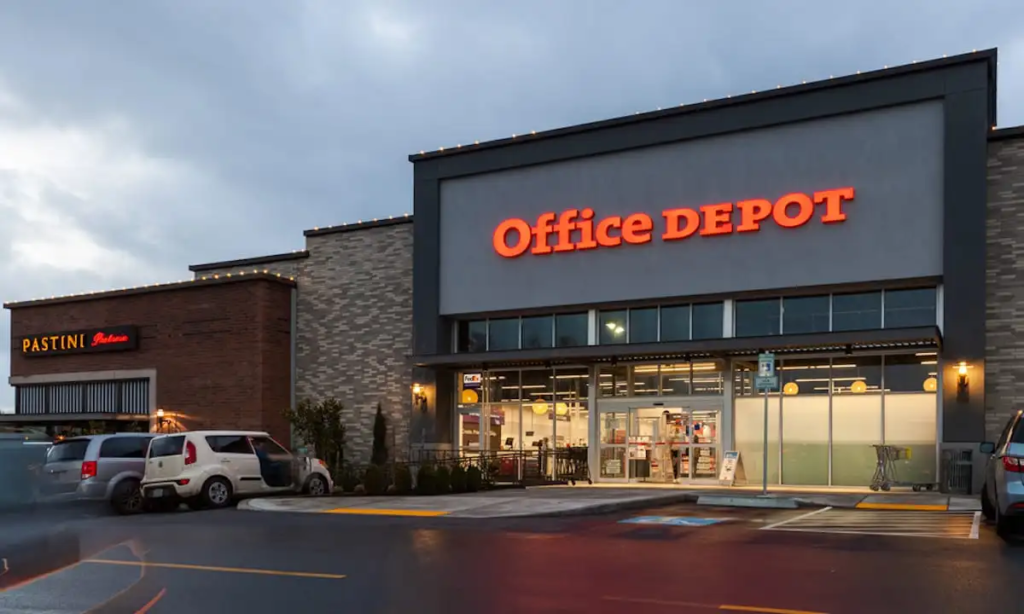Office Depot, a staple in the world of office supplies and business services, has carved out a significant niche in the retail and business-to-business sectors. Since its inception, the company has evolved in response to changing market demands, technological advancements, and shifts in consumer behavior. This article delves into the history, growth, challenges, and strategic initiatives of Office Depot, highlighting its journey from a single store to a global powerhouse in the office supply industry.
Early Years: The Founding and Initial Growth
The Birth of Office Depot
Office Depot was founded in 1986 by F. Patrick Sher, Stephen Dougherty, and Jack Kopkin in Fort Lauderdale, Florida. The trio saw a burgeoning demand for office supplies, fueled by the rise of small businesses and home offices. They envisioned a retail chain that could offer a wide range of products at competitive prices, coupled with exceptional customer service. This vision materialized with the opening of their first store, which was met with immediate success.
Rapid Expansion
The late 1980s and early 1990s were characterized by rapid expansion for Office Depot. The company capitalized on its early success by opening new stores across the United States. By 1990, Office Depot had become the largest office supply retailer in the country, boasting over 100 stores. This growth was fueled by a combination of strategic store placements, a broad product selection, and a strong emphasis on customer satisfaction.
Navigating the Competitive Landscape
Competitors and Market Dynamics
As Office Depot expanded, it faced increasing competition from other office supply retailers such as Staples and OfficeMax. Each of these competitors brought unique strengths to the market, creating a highly competitive landscape. To stay ahead, Office Depot continuously adapted its business model, investing in technology, improving supply chain efficiency, and diversifying its product offerings.
Mergers and Acquisitions
One of the significant strategies Office Depot employed to maintain its competitive edge was through mergers and acquisitions. In 1991, the company merged with The Office Club, a deal that significantly expanded its reach on the West Coast. This merger was a critical step in Office Depot’s strategy to become a national retailer.
In 1998, Office Depot made another strategic move by merging with Viking Office Products, a leading global supplier of office products. This merger not only broadened Office Depot’s product range but also strengthened its presence in international markets.

The Digital Transformation
Embracing E-Commerce
The late 1990s and early 2000s marked the beginning of the digital revolution, and Office Depot was quick to recognize the potential of e-commerce. In 1998, the company launched its online store, OfficeDepot.com, which provided customers with a convenient way to shop for office supplies from the comfort of their homes or offices. This move proved to be a game-changer, as it allowed Office Depot to reach a broader audience and cater to the growing trend of online shopping.
Technological Innovations
Office Depot also invested heavily in technology to enhance its operational efficiency and customer experience. The company implemented advanced inventory management systems, which helped in optimizing stock levels and reducing lead times. Additionally, Office Depot introduced various digital tools and services, such as online printing and cloud storage solutions, to cater to the evolving needs of its customers.
Challenges and Adaptation
Economic Downturns
Like many other retailers, Office Depot faced significant challenges during economic downturns, particularly during the Great Recession of 2008. The recession led to reduced consumer spending, which directly impacted Office Depot’s sales and profitability. To navigate these tough times, the company undertook several cost-cutting measures, including store closures and workforce reductions. Despite these challenges, Office Depot remained resilient and focused on long-term growth strategies.
The Rise of Remote Work
The COVID-19 pandemic in 2020 brought about unprecedented changes in the way people work. With the sudden shift to remote work, the demand for traditional office supplies declined, while the need for home office equipment surged. Office Depot adapted to this new reality by expanding its product offerings to include home office furniture, tech accessories, and ergonomic solutions. The company also enhanced its online shopping experience to cater to the increased demand for home delivery and curbside pickup services.
Strategic Initiatives and Future Prospects
Diversification of Services
In recent years, Office Depot has diversified its services to go beyond just office supplies. The company has positioned itself as a comprehensive business solutions provider, offering services such as IT support, managed print services, and business consulting. This diversification has not only helped Office Depot attract new customers but also deepened its relationships with existing ones.
Focus on Sustainability
Sustainability has become a critical focus for Office Depot. The company has implemented various initiatives to reduce its environmental footprint, such as offering recycled products, reducing packaging waste, and promoting energy-efficient practices in its operations. Office Depot’s commitment to sustainability resonates with environmentally conscious consumers and aligns with global efforts to combat climate change.
Community Engagement
It has also been actively involved in community engagement and corporate social responsibility (CSR) initiatives. The company supports various charitable organizations and educational programs, emphasizing its commitment to giving back to the communities it serves. These efforts not only enhance Office Depot’s brand reputation but also foster a positive impact on society.
Innovation and Technological Advancements
Looking ahead, Office Depot continues to prioritize innovation and technological advancements. The company is exploring emerging technologies such as artificial intelligence (AI) and machine learning to enhance its supply chain operations and customer service. Additionally, Office Depot is investing in digital platforms to provide seamless omnichannel experiences, ensuring that customers can shop conveniently across online and offline channels.
Conclusion
Office Depot’s journey from a single store in Florida to a global leader in office supplies and business services is a testament to its resilience, adaptability, and commitment to customer satisfaction. Despite facing numerous challenges and a highly competitive landscape, the company has continuously evolved to meet the changing needs of its customers. As Office Depot looks to the future, its focus on diversification, sustainability, and innovation positions it well to navigate the ever-changing business environment and continue its legacy of excellence.
Office Depot’s story is one of constant adaptation and growth, driven. By a relentless pursuit of innovation and a deep understanding of its customers’ needs. From its early days of rapid expansion to its current status as a comprehensive business solutions provider, Office Depot’s journey. Is a remarkable example of how a company can thrive by staying true to its core values while embracing change. As the business landscape continues to evolve, this is well-equipped to face new challenges and seize emerging opportunities, ensuring its continued success for years to come.
4o

















Преимущества кредита под залог, исследуйте.
получить кредит под залог дома http://www.ctekc.ru .
Все о мобильной версии зеркала казино Вавада: играйте и выигрывайте на ходу
Вавада вход зеркало https://casinovavada-official.ru/ .
Качественные дубликаты гос номеров по доступной цене
номер авто дубликат http://www.vip-dublikat-nomerov.ru/ .
Казино Чемпион: Получи бонусы за регистрацию
Champion casino бездепозитный бонус https://www.dk-slavniy.ru/ .
Отдых в Гаграх 2024: Снять жилье у моря по доступным ценам
отдых в гаграх цены https://www.otdyh-v-gagrah.ru .
Сантехник по вызову: стоимость монтажа сантехники
сантехника прайс лист цен за работу http://santehnik-spb-cena.ru/ .
Магазин запчастей МТЗ: Профессиональный сервис и поддержка
запчасти мтз беларусь http://www.zapchasty-mtz.ru/ .
Зип пакеты с бегунком: Экономия места и максимальное удобство
zip пакеты с бегунком http://www.zip-lock-pakety.ru .
Комплексный вывод из запоя: Психологическая и медицинская помощь
круглосуточный вывод из запоя самара круглосуточный вывод из запоя самара .
Клининг квартир и домов: Высокое качество и доступные цены
сайт клининговой компании https://www.klining-kompaniya-msk.ru/ .
Онлайн Казино Чемпион: Твой билет к удаче и огромным выигрышам
казино Чемпион онлайн казино Чемпион онлайн .
Лечение алкоголизма и наркомании в Самаре: Опытные наркологи
клиника наркологии в самаре http://narkolog-klinika-samara-1.ru/ .
Как вывести из запоя без риска для здоровья: советы от наркологической клиники
Вывод из запоя на дому в Алматы http://www.vivodizzapoyaalmaty1.kz/ .
Что такое медикаментозный вывод из запоя
Вывод из запоя на дому в Алматы http://vivodizzapoya1.kz/ .
Вывод из запоя под ключ: Комплексный подход к лечению
Вывод из запоя на дому в Алматы http://vivodizzapoya.kz/ .
GK Peresvet: консультации по выбору винтовых свай бесплатно
Сваи Пересвет: купить сваи винтовые для фундамента
Ремонт иномарок с гарантией качества и без переплат
ремонт иномарок в спб https://www.remont-inomarok-spb.ru/ .
Вывод из запоя на дому: вызов врача без лишних вопросов
Снять алкогольную интоксикацию на дому https://vivodizzapoyavalmaty.kz/ .
Лечение наркомании в Алматы: Комплексная помощь в наркологическом центре
Кодирование от алкоголизма в Алматы Кодирование от алкоголизма в Алматы .
Продажа Cummins 6 ISBe: Двигатели с лучшими техническими характеристиками
камминз 6isbe https://www.cummins-6isbe-1.ru .
Обзор характеристик двигателя Cummins 6 ISBe: Что нужно знать
двс cummins 6isbe https://cummins-6isbe-1.ru .
Надежные решения для бизнеса — Перевозки из Китая в Казахстан
грузоперевозки из китая в казахстан https://perevozki-kitai-kazahstan.ru .
Лучшие элитные шубы в Москве: популярные магазины и салоны
шубы москва шубы москва .
Выбор дизайнеров: УФ печать на дереве от компании, которой доверяют профессионалы
печать на дереве цена печать на дереве цена .
Как выбрать шубу из баргузинского соболя, чтобы подчеркнуть свою индивидуальность
дорогая шуба из соболя https://www.shuby-sobol.ru .
УФ печать на керамике: заказать индивидуальные элементы декора
уф печать цены https://shirokoformatnaya-uf-pechat.ru .
Как подобрать идеальный пансионат для пожилого человека: рекомендации экспертов
платный пансионат для пожилых https://pansionaty-dlya-pozhilyh2.ru .
Закажите УФ печать на дереве недорого – мы предлагаем лучшее соотношение цены и качества
печать на дереве http://www.pechat-derevo.ru .
Зимние подарочные наборы для семейных праздников: создайте волшебство в каждый дом
Кухонные подарочные наборы https://gift31.ru .
Что говорят о чистке лимфы солодкой и полисорбом: честные отзывы
как почистить лимфу солодкой и энтеросгелем https://clinika-moscow.ru .